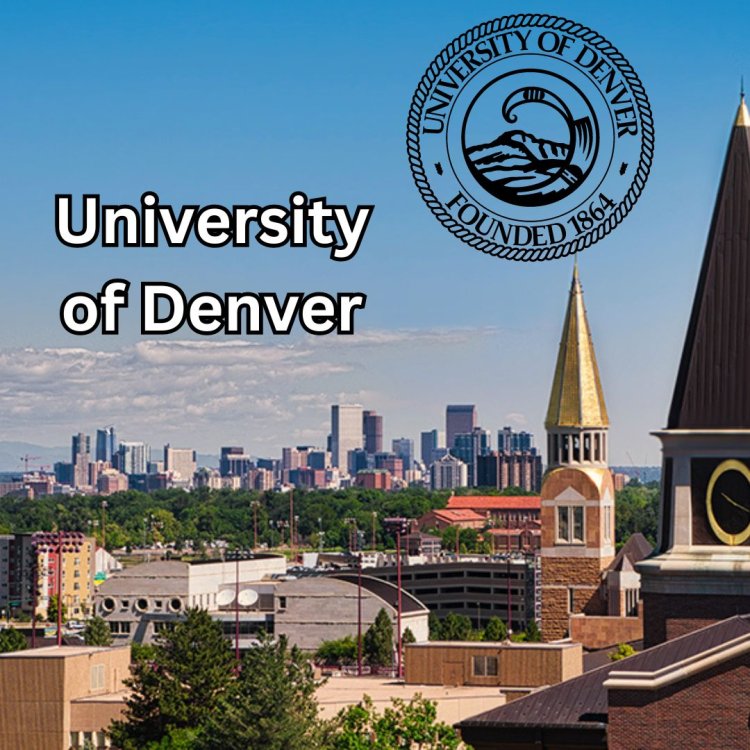University of Denver: University College Denver Graduate Programs
Embark on a transformative journey towards academic excellence with the University of Denver's University College Denver Graduate Programs.

In this comprehensive guide, we delve into the distinctive features and advantages that set these programs apart, offering a compelling overview for prospective students seeking an unparalleled educational experience.
University of Denver
The University of Denver is a private institution that was founded in 1864. It has a total student population of 6,160 (Fall 2022), an urban setting, and a campus size of 125 acres. It uses a quarterly academic calendar. The University of Denver's ranking in the 2024 edition of Best Colleges is National Universities, #124. His tuition and fees are $59,340.
The University of Denver campus spans 125 acres and is located just a few miles from downtown Denver. Students interested in living among the Colorado Rockies can study at the university's Kennedy Mountain campus. DU is also home to the well-regarded Sturm College of Law. Students can join more than 100 student clubs and organizations, including nearly 20 fraternities and sororities.
Freshmen and sophomores, with exceptions, must live on campus. Student athletes compete on the Denver Pioneers sports teams who are members of the NCAA Division I Summit League. The school's ski team has won more national championships than any other program in the country.
Notable alumni include Condoleezza Rice, former US Secretary of State; Michelle Kwan, Olympic medalist figure skater; Chris Broderick, former guitarist of the heavy metal band Megadeth; and James Cox Kennedy, chairman emeritus and former CEO of telecommunications company Cox Enterprises.
About Denver
Denver, a city and county, is the capital of Colorado, USA, on the western edge of the Great Plains, just east of the Front Range of the Rocky Mountains. The city and county were merged as one administrative unit in 1902. Denver is located at the confluence of Cherry Creek and the South Platte River. Its elevation (5,280 feet [1,609 meters] above sea level at the State Capitol) gives it the nickname "Mile High City".
Post-World War II metropolitan growth created a ring of suburban communities, including Arvada, Aurora, Brighton, Broomfield, Cherry Hills Village, Englewood, Lakewood, Littleton, Northglenn, Thornton, Westminster, and Wheat Ridge; Golden, about 12 miles (19 km) west of Denver, and Boulder, about 25 miles (40 km) northwest, are also part of the metropolitan area.
Greater Denver is the center of a series of urban areas that stretch along the Front Range from Fort Collins in the north to Pueblo in the south. Inc. 1885. County town, 155 sq mi (401 sq km). Pop. (2010) 600,158; Denver-Aurora-Broomfield Metro Area, 2,543,482; (2020) 715,522; Denver-Aurora-Lakewood metro area, 2,963,821.
Contemporary City
Today's Denver metropolitan area extends well into the foothills west of the city and into the high plains that surround it on the other three sides. In addition, Boulder, home to the main campus of the University of Colorado, is now connected to the metropolis by an almost continuous built-up suburban corridor.
People of European descent make up the majority of Denver's population, but people of Hispanic (mainly Mexican) descent make up a growing third of its residents; a relatively small proportion (about one-tenth) are African American, with even smaller numbers Asian and Native American.
The region's rapid growth since the 1950s has increased pressure on its infrastructure, especially water and transportation systems. The bulk of Denver's water supply comes from spring snowmelt in the mountains, which is stored in large reservoirs or diverted from the South Platte River and other streams. During periods of drought, it is sometimes necessary to limit water consumption.
The vast majority of Denverites rely on automobiles for transportation, and traffic congestion and pollution from automobile emissions are chronic problems; sometimes the residents' view of the mountains is obscured by smog. One approach to reducing car use has been to build a light rail system, the first line of which opened in 1994.
How Large is The City
As the largest city in the vast area between the Missouri River and the Pacific states, Denver serves as a transportation, industrial, and commercial hub and is a center for high-tech industries. Major businesses include telecommunications, aerospace, software, financial and business services, and healthcare. Tourism is the primary economic factor. Electronics, computer equipment, rubber products, luggage, pharmaceuticals, medical equipment and packaging are manufactured, and there is a large brewery in nearby Golden.
The Denver branch of the US Mint (opened as a mint in 1906) produces about half of the coins in circulation in the US and is the second largest depository of gold in the country. Denver International Airport, one of the nation's largest, opened in 1995 and is located about 23 miles (37 km) northwest of the city.
The city is home to the University of Denver (1864), Regis University (1877), Iliff School of Theology (1892), Metropolitan State University of Denver (1965), and a branch campus and Health Sciences Center of the University of Colorado. The State Capitol (built 1887–95 in the Corinthian style) has a 272-foot (83-meter) gold dome, and Civic Center Park adjoins the Capitol grounds. Denver's climate and geography make outdoor recreation especially popular.
The Rocky Mountains
The Rocky Mountains begin a few miles west of town and provide opportunities for skiing, hiking and mountain biking. Many ski areas are within driving distance, including Winter Park Resort, which is part of the city's park system; rafting on nearby Clear Creek and the Arkansas River further southwest is popular in warmer weather. Cycle paths are also spread throughout the city itself. Denver Mountain Parks, in addition to more than 200 parks in the city, extend into the mountains and are scattered across a wide scenic area.
Denver has professional baseball, basketball, football, hockey, and soccer (soccer). City attractions include the Black American West Museum and Heritage Center, Colorado History Museum, Denver Museum of Nature and Science, MCA (Museum of Contemporary Art) Denver, and Denver Botanic Gardens. The Denver Zoo in a city park houses nearly 4,000 animals, and Colorado's Ocean Journey is the West's only aquarium outside of the Pacific Coast region.
The Denver Art Museum contains a renowned collection of Native American and Western art; a new wing, designed by Daniel Libeskind, was added in 2006. Music and theater events are held at Red Rocks Park and Amphitheater, an outdoor venue in the foothills west of the city, and the Denver Performing Arts Complex is home to the State Ballet, Opera, and Symphony Orchestra. The annual National Western Stock Show (held in January) includes a rodeo as well as livestock and horse shows. Rocky Mountain National Park is located northwest of the city.
Campus
At the heart of the campus are a number of historic buildings. The longest standing building is University Hall, which has served DU since 1890 and was built in the Richardson Romanesque style. The cornerstone of this building is exactly one mile above sea level. Just a few blocks from campus is the historic Chamberlin Observatory, opened in 1894. The observatory, still fully functional, is open to the public twice a week and one Saturday a month.
Administrative offices are located in the Mary Reed Building, a former library built in 1932 in the Collegiate Gothic style. Margery Reed Hall (named for Mary Reed's daughter) was also built in the Collegiate Gothic style in 1929. Margery Reed Hall houses the undergraduate program for the Daniels College of Business; an $8 million overhaul and renovation was completed in early 2014. The building was updated to include more classroom space, a larger hall to host guest speakers, as well as mechanical and technical improvements.
F. W. Olin Hall opened in 1997, housing the biological and natural sciences. The 40,000-square-foot structure was the first building on campus built to meet a new set of design and aesthetic standards emphasizing load-bearing masonry, organic designs, and timeless architectural elements. Olin Hall includes a two-story rotunda topped by an elliptical copper dome that stands guard over the university skyline.
In 2002, the university opened the $70 million Robert and Judi Newman Center for Performing Arts, home to the acclaimed Lamont School of Music. The center includes the June Swaner Gates Concert Hall, a four-story opera house with a capacity of just under 1,000, the Frederic C. Hamilton Family Recital Hall, a 222-seat recital hall and the largest (2,850-pipe) pipe organ in the region. , and the Elizabeth Ericksen Byron Theatre, a flexible theater space with a capacity of up to 350 seats. The Newman Center serves as home to many professional theater groups from the Denver region, as well as the university's Newman Center Presents multidisciplinary performing arts series.
Athletics
DU's athletic teams are known as the Denver Pioneers. The school has fielded track and field teams since 1867 and has won 33 NCAA Division One titles since 1949 – among the top 15 of all schools. Denver is best known as a major powerhouse in winter sports, especially skiing and ice hockey. DU has won 24 NCAA national skiing championships (more than any other school). Ice hockey is DU's flagship spectator sport with nine NCAA titles (tied for first among all schools), most recently in 2022 and including back-to-back crowns in 2004 and 2005. The program has produced 75 NHL players and regularly sells out the 6,000-capacity Magness Arena locations on campus, a showcase of the Ritchie Center for Sports and Wellness.
The Pioneers' major conferences changed in July 2013. Denver moved its primary affiliation from the Western Athletic Conference to The Summit League, hockey moved from the Western Collegiate Hockey Association to the National Collegiate Hockey Conference, and men's lacrosse moved from the ECAC Lacrosse League to the Big East Conference. The women's lacrosse team also moved from the Mountain Pacific Sports Federation (MPSF) to the Big East Conference in 2017 and reached the Elite 8 (quarterfinals) of the NCAA Tournament in 2019. Additionally, the women's gymnastics team joined the newly formed Mountain Rim Gymnastics Conference in 2013 and later moved to the Big 12 Conference in July 2015.
The Pioneers won the 2015 men's lacrosse national championship, defeating Maryland, 10-5. They were the first Division I men's team west of the Appalachians to win the NCAA Men's Lacrosse National Championship. The 2016 men's soccer team advanced to the NCAA College Cup.
Conclusion
In conclusion, the University of Denver's University College Denver Graduate Programs promise an enriching academic experience. With a legacy of excellence, diverse programs, renowned faculty, and state-of-the-art facilities, we invite you to join us in shaping a successful future. Explore the possibilities and elevate your educational journey with us.
What's Your Reaction?







![Apply for a Student Visa in New Zealand [Requirements & Checklist]](https://mouthytech.com/uploads/images/202504/image_650x434_67fc96fe20e0d.jpg)












